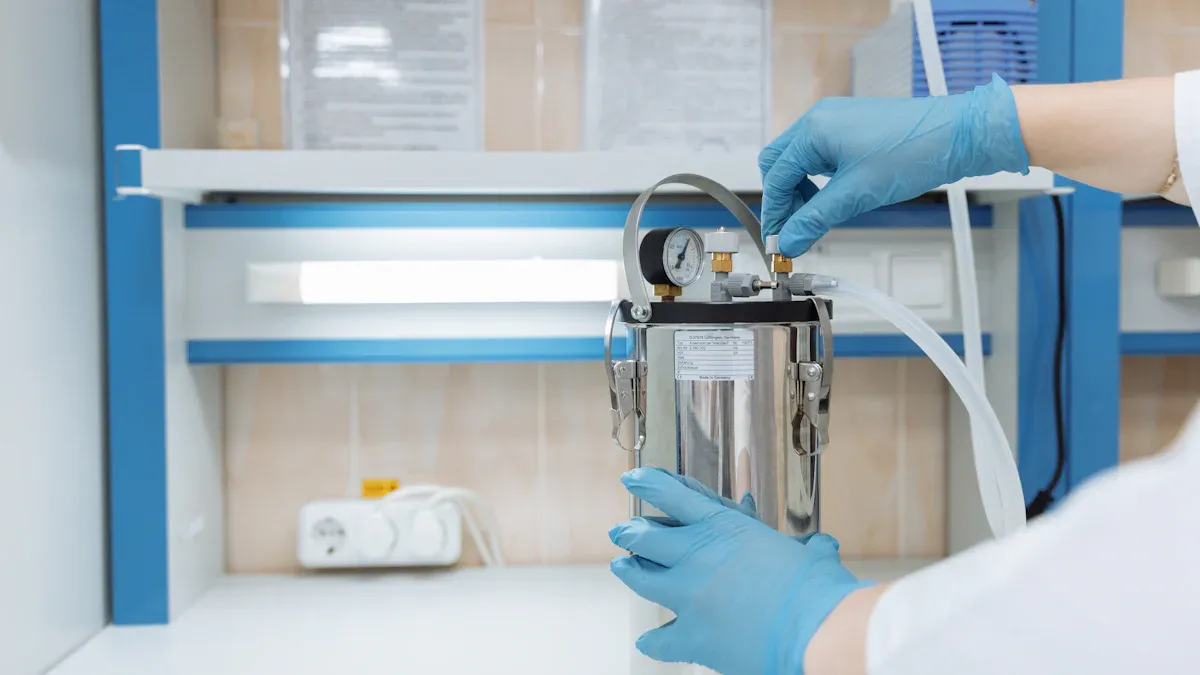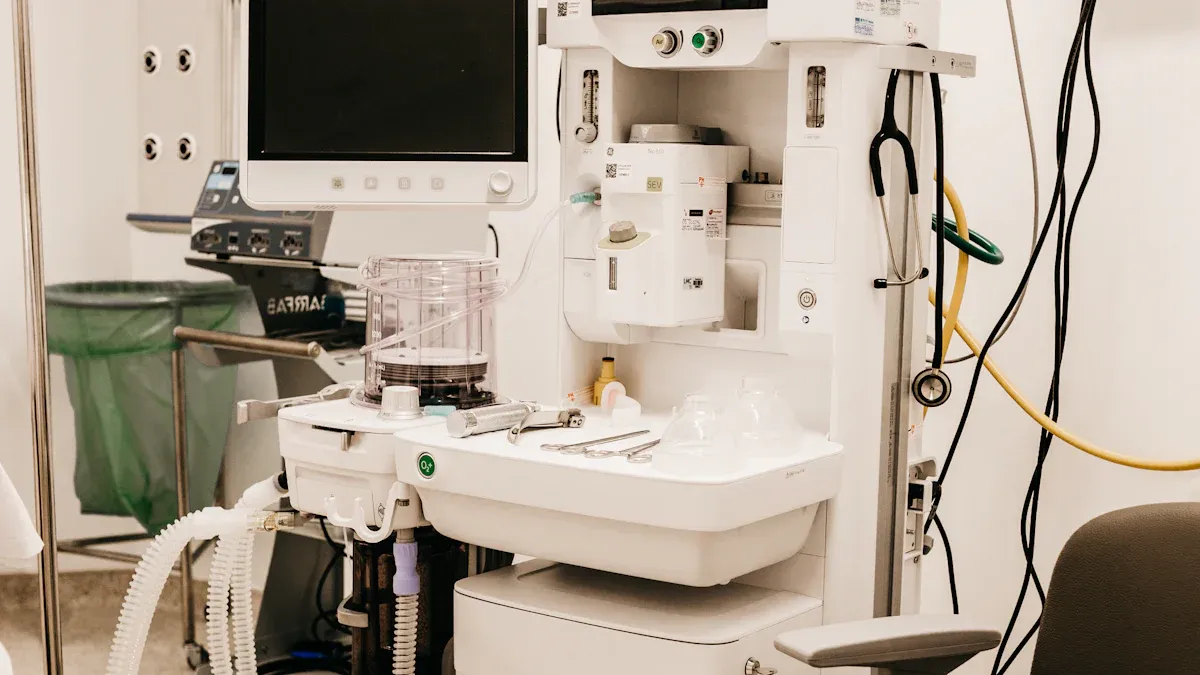Key Updates on ASTM F2063 Nitinol Tubing Standards in 2025

ASTM F2063 nitinol tubing is still the main choice for medical devices and wearables in 2025. The standard has not changed in what it covers. But now, manufacturers use new tubing types, better supply chains, and very pure nitinol alloys. These updates help make medical wearables and new tubing for high-performance uses. Clinical studies show nitinol stents work well 97% of the time in brain blood vessel procedures. ASTM F2063 nitinol tubing follows strict rules for chemical makeup, size limits, and strength. It can last through over 600 million heartbeats without breaking.
Parameter | Statistical Data |
|---|---|
Nickel Content | 54.5% - 57.0%, strict impurity limits |
Superelastic Strain | Up to 7% |
Clinical Success Rate | 97% in neurovascular medical devices |
Endurance | 600+ million cycles |
Dimensional Tolerance | ±0.005 mm for tubing below 0.3 mm |
Manufacturers, suppliers, and developers get many benefits from these changes. They can make safer and more reliable nitinol tubing for medical and wearable devices. ASTM F2063 nitinol tubing helps keep products safe, strong, and better for patients.
Key Takeaways
ASTM F2063 is still the main rule for nitinol tubing in 2025. It helps keep medical and wearable devices safe and good quality.
New nitinol tubing types bend better and last longer. This helps devices work well and helps patients heal faster.
Ultra-pure nitinol alloys make tubing stronger and safer. This makes medical devices last longer and work better.
Better supply chains bring nitinol tubing faster and with better quality. This helps keep making devices and keeps them ready to use.
Makers use new tools and strong tests to follow ASTM rules. This makes sure nitinol tubing is safe and works well every time.
ASTM F2063 Nitinol Tubing Overview

Nitinol Tubing Standards
Nitinol tubing standards help keep medical devices safe and high quality. ASTM F2063 nitinol tubing is the main guide for companies making shape memory alloys for medical use. These rules say what chemicals, strength, and sizes nitinol tubing should have. Companies use these rules to make sure tubing is strong, bends well, and works safely in the body.
ASTM F2063 gives the chemical and metal rules for nitinol in mill forms, which are used to start making tubing.
Keeping oxygen and carbon low stops hard spots that could make tubing weak or break.
Steps like melting, forging, gun-drilling, and drawing change how strong and flexible the tubing is.
Heating and shaping steps give nitinol tubing its special memory and superelastic features for medical use.
Careful checks of roundness and smoothness help nitinol tubing work well in stents and other important medical tools.
Note: ISO 13485:2016 certification works with ASTM F2063 nitinol tubing standards. This certification makes companies keep good records, check their work, and look for risks. These steps help nitinol tubing meet world rules and keep medical devices safe and reliable.
ASTM F2063 Scope
ASTM F2063 is still the only standard for nitinol tubing in 2025. This rule covers everything about nitinol tubing used in medical devices, like what it is made of, how strong it is, and if it is safe for the body. ASTM F2063 nitinol tubing must pass tough tests for strength, stretching, shape changes, and safety in the body. These tests make sure nitinol tubing works well in important medical devices.
Companies must follow ASTM F2063 to meet industry and government rules. Getting certified means keeping careful records and test results to show each batch of nitinol tubing is the best quality. ASTM F2063 nitinol tubing helps with safe sourcing, following rules, and making products you can trust. Studies and long-term data show ASTM F2063 nitinol tubing is safe for the body and rarely causes problems, so it is trusted for medical use.
2025 Updates and Advancements

No Major Scope Changes
ASTM F2063 still leads the way for nitinol tubing in 2025. The standard did not change its main rules. This helps companies keep making safe medical devices and wearables. Companies trust ASTM F2063 for clear rules and good tubing. The rules staying the same help the market stay steady. Device makers know what to expect from nitinol tubing. ASTM F2063 still lists the rules for what is in the tubing, how strong it is, and if it is safe for the body. These rules help keep patients safe and let new ideas grow in medical and wearable devices.
New Nitinol Tubing Types
Now, companies make new nitinol tubing that bends better and lasts longer. These new types help medical and wearable devices work better and last more years. Superelastic nitinol tubing can bend and go back to its shape. This makes stents, guidewires, and wearables safer and more reliable.
The newest tubing, like TM-1, works much better than old types. Devices with these new tubes help patients heal faster and last longer. The table below shows important facts:
Performance Metric | Quantitative Evidence and Benefit |
|---|---|
Fatigue Life | Up to 3 times longer lifespan compared to traditional materials. |
Bend Endurance | Can withstand over 10 million bending cycles without failure. |
Tubing Size Precision | Manufacturing accuracy down to 0.001 inches or better. |
Patient Recovery Time | Devices using new tubing enable 20% faster recovery times. |
TM-1 Tubing Variant | Lasts 2-3 times longer and endures over 10 million bends. |
Market Growth Projection | 65% increase in nitinol use in electronics by 2026, indicating adoption benefits. |
These new nitinol tubes help wearable and medical devices work better. Longer fatigue life and bend strength mean nitinol tubing can take more use and stress. This makes it great for tough jobs in medical and wearable devices.
Ultra-Pure Nitinol Alloys
Ultra-pure nitinol alloys are now the top choice for high-purity tubing. Companies use new ways to melt and clean the metal to get rid of bad stuff. This makes tubing stronger, more bendy, and safer for the body. High-purity nitinol tubing meets all the tough ASTM F2063 rules.
Alloys like SE-508 ELI are now common in medical and wearable devices. These alloys last longer and do not break as easily. High-purity nitinol tubing helps make safer and better shape memory alloys for important medical uses. Makers can now build products that last longer and work better, even in hard places.
Supply Chain Improvements
The nitinol tubing supply chain got much better in 2025. More money went into making tubing and checking quality. This means tubing is ready faster and is more reliable. Confluent and ATI made more tubing and now can send it out in 4-6 weeks. This helps device makers get what they need quickly.
Resonetics also made it easier to get custom nitinol tubing fast. They now melt metal themselves and keep more in stock. This helps stop delays in the future. These changes make sure there is always enough high-purity nitinol tubing for medical and wearable devices.
Quality checks now include:
Quality Control Measure | Description |
|---|---|
Tight Dimensional Tolerances | Achieved tolerances as low as ±0.0005 inches, ensuring consistent performance across applications. |
Improved Surface Quality | Advanced polishing techniques reduce surface roughness, enhancing fatigue resistance and biocompatibility. |
Non-Destructive Testing | Uses ultrasonic and eddy current methods to detect flaws without damaging the material. |
Dimensional Inspections | Verifies tubing meets precise specifications for outer diameter, wall thickness, and concentricity. |
Mechanical Testing | Evaluates strength, elasticity, and fatigue resistance through tensile and bend tests. |
These supply chain changes help meet the need for more medical and wearable devices. Companies can now get tubing that meets ASTM F2063 rules and nitinol standards more easily. This means faster shipping, better quality, and safer products for people who use them.
Manufacturing and Compliance
Manufacturing Impact
Manufacturers are making big changes to nitinol tubing in 2025. Companies like Confluent Medical and ATI Specialty Alloys spent over $50 million to improve their tools. This helps them make more nitinol tubing for wearables and medical devices. Now, companies control nitinol from the start to the end. This means they can react fast when people need more tubing and keep quality high.
Manufacturing Impact | Details | Effect on Production Efficiency |
|---|---|---|
Large Capital Investment | Over $50 million spent on new tools and machines | More nitinol tubing, better supply for wearables and medical devices |
Vertically Integrated Supply | Control from raw nitinol to finished tubing | Fast response to demand, high standards |
Reduced Lead Times | Lead times dropped from 14-20 weeks to 4-6 weeks | Faster delivery, improved throughput |
Technological Advancements | Better temperature control, 3D printing, laser cutting | Faster, more exact nitinol tubing, complex shapes possible |
Thin Film Nitinol Methods | Vacuum sputter deposition makes thin film tubing | Stronger, smaller tubing for wearables and medical tools |
Supply Chain Strengthening | Automation, risk management, more suppliers | Fewer delays, stable costs, reliable nitinol tubing supply |
3D printing and laser cutting help make nitinol tubing more exact. Thin film nitinol methods make tubing smaller and more flexible. Automation and risk planning keep the supply chain strong and steady.
Compliance Steps
Manufacturers must follow steps to meet ASTM rules for nitinol tubing. First, they get nitinol that fits ASTM F2063. Every batch needs records about chemicals, strength, safety, and if it is safe for the body. Companies keep these records to show the tubing meets all the rules.
Tip: Digital tracking systems help organize tubing records and make audits faster.
Next, companies test the tubing for size, roundness, and smoothness. They use special tests to find problems without breaking the tubing. All test results go into files for compliance. For wearable devices, companies must show the tubing meets ASTM and safety rules.
For government approval, companies write reports with all test results and records. These reports prove nitinol tubing is safe for wearables and medical devices. Reports must use the electronic Common Technical Document (eCTD) format. If files are not tagged right, agencies might not accept them.
Regulatory Considerations
Regulatory agencies watch nitinol tubing supply and quality closely. The FDA says 27% of drug shortages come from raw material problems. This means strong supply chains and following ASTM rules are very important. If companies change nitinol tubing or materials, regulators call these changes major, moderate, or minor. Each type needs different approval steps.
Regulatory reports include research, clinical trial data, and how the tubing is made. In the United States, companies use New Drug Applications (NDA) or Investigational New Drug Applications (INDA) for approval. These reports show nitinol tubing is safe for wearables and medical devices.
Harmonization and quality programs help companies keep up with new rules. These programs make it easier to follow changes and keep nitinol tubing ready for all kinds of wearable devices.
ASTM F2063 still covers nitinol tubing in 2025. Nitinol tubing is now cleaner and comes in new types. Companies can get nitinol tubing faster than before. Device makers need to check the tubing for quality. They also have to keep good records about it. Nitinol tubing helps medical devices stay safe and strong. It must pass tests for strength and safety. New nitinol alloys make tubing last longer. Nitinol tubing works well in wearable devices. There are more choices for device makers now. Nitinol tubing helps people trust medical products.
FAQ
What makes nitinol tubing important for medical devices?
Nitinol tubing can bend and go back to its shape. Doctors use it in stents and other tools. It stays strong and safe inside the body. Nitinol tubing lasts a long time. This helps patients heal better.
How does nitinol improve the performance of wearable devices?
Nitinol keeps wearable devices flexible and strong. The tubing can bend many times and not break. This makes wearables more comfy and reliable. Nitinol tubing keeps its shape after lots of use.
Why do manufacturers choose high-purity nitinol tubing?
Manufacturers use high-purity nitinol tubing because it has less bad stuff. This makes it safer for the body. High-purity nitinol tubing lasts longer and works better in devices.
What tests check the safety and biocompatibility of nitinol tubing?
Companies test nitinol tubing for strength and bending. They also check the chemical makeup. Tests show if the tubing is safe for the body. These tests make sure nitinol tubing meets all safety rules.
How do supply chain changes affect nitinol tubing availability?
Better supply chains mean nitinol tubing comes faster and is better quality. Companies get tubing when they need it. This helps them make more devices without waiting.
See Also
The Future Impact of Nitinol Tubes on Medical Devices
The Process Behind Manufacturing Nitinol Tubing for Medicine
The Importance of Nitinol Tubing in Modern Medical Uses
Nitinol Tubing’s Contribution to Medical Technology Progress
Discovering How Nitinol Tubing Enhances Healthcare Equipment

